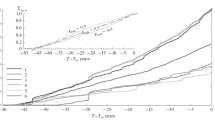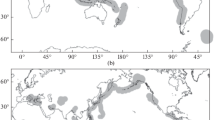Abstract
During 11 sequences of earthquakes that in retrospect can be classed as foreshocks, the accelerating rate at which seismic moment is released follows, at least in part, a simple equation. This equation (1) is\(d(\Sigma \sqrt {M_0 } )/dt = C/(t_f - t)^n\),where\(\Sigma \sqrt {M_0 }\) is the cumulative sum until time,t, of the square roots of seismic moments of individual foreshocks computed from reported magnitudes;C andn are constants; andt fis a limiting time at which the rate of seismic moment accumulation becomes infinite. The possible time of a major foreshock or main shock,t f,is found by the best fit of equation (1), or its integral, to step-like plots of\(\Sigma \sqrt {M_0 }\) versus time using successive estimates oft fin linearized regressions until the maximum coefficient of determination,r 2,is obtained. Analyzed examples include sequences preceding earthquakes at Cremasta, Greece, 2/5/66; Haicheng, China 2/4/75; Oaxaca, Mexico, 11/29/78; Petatlan, Mexico, 3/14/79; and Central Chile, 3/3/85. In 29 estimates of main-shock time, made as the sequences developed, the errors in 20 were less than one-half and in 9 less than one tenth the time remaining between the time of the last data used and the main shock. Some precursory sequences, or parts of them, yield no solution. Two sequences appear to include in their first parts the aftershocks of a previous event; plots using the integral of equation (1) show that the sequences are easily separable into aftershock and foreshock segments. Synthetic seismic sequences of shocks at equal time intervals were constructed to follow equation (1), using four values ofn. In each series the resulting distributions of magnitudes closely follow the linear Gutenberg-Richter relation logN=a−bM, and the productn timesb for each series is the same constant. In various forms and for decades, equation (1) has been used successfully to predict failure times of stressed metals and ceramics, landslides in soil and rock slopes, and volcanic eruptions. Results of more recent experiments and theoretical studies on crack propagation, fault mechanics, and acoustic emission can be closely reproduced by equation (1). Rate-process theory and continuum damage mechanics offer leads toward understanding the physical processes.
Similar content being viewed by others
References
Anderson, O. L. andGrew, P. C. (1977),Stress corrosion theory of crack propagation with applications to geophysics, Rev. Geophys. Space Physics15, 77–104.
Ashby, M. F. andDyson, B. F. (1986),Creep damage mechanics and micromechanisms, Advances in Fracture Research (Fracture 84)1, 3–30, Pergamon Press.
Benioff, H. (1951),Earthquakes and rock creep, Part I: Creep characteristics of rocks and the origin of aftershocks, Bull. Seismol. Soc. Am.41, 31–62.
Comninakis, P., Drakopoulos, J., Moumoulidis, G., andPapazachos, B. (1968),Foreshock and aftershock sequences of the Cremasta earthquake and their relation to the waterloading of the Cremasta artificial lake, Annali di Geofisica21, 39–71.
Comte, D., Eisenberg, A., Lorca, E., Pardo, M., Ponce, L., Saragoni, R., Singh, S. K., andSu-Árez, G. (1986),The 1985 central Chile earthquake: A repeat of previous great earthquakes in the region? Science233, 449–453.
Das, S. andScholz, C. H. (1981),Theory of time-dependent rupture in the earth, J. Geophys. Res.86, 6039–6051.
Das Gupta, A. (1984),Observed amplitude changes and seismic activity prior to two recent earthquakes in the Himachal Himalayas, India, Tectonophysics104, 375–386.
Dieterich, J. H. (1986),A model for the nucleation of earthquake slip, InEarthquake Source Mechanics (eds. Das, S., Boatwright, J. and Scholz, C. H.) (Am. Geophys. Union) Geophys. Mon.37, 37–47.
Endo, E. T., Malone, S. D., Noson, L. L., andWeaver, C. S. (1981),Locations, magnitudes, and statistics of the March 20–May 18 earthquake sequence, InThe 1980 Eruptions of Mount St. Helens, Washington (eds. Lipman, P. W. and Mullineaux, D. R.) (Denver, Colo.) USGS Prof. Paper1250, 93–121.
Frankel, A. (1982),Precursors to a magnitude 4.8 earthquake in the Virgin Islands: Spatial clustering of small earthquakes, anomalous focal mechanisms, and earthquake doublets, Bull. Seismol. Soc. Am.72, 1277–1294.
Gettrust, J. F., Hsu, V., Helsley, C. E., Herrero, E., andJordan, T. (1981),Patterns of local seismicity preceding the Petatlan earthquake of 14 March 1979, Bull. Seismol. Soc. Am.71, 761–769.
Gupta, H. K., Rastogi, B. K., andNarain, Hari (1972),Common features of the reservoir-associated seismic activities, Bull. Seismol. Soc. Am.62, 481–492.
Hsu, V., Gettrust, J. F., Helsley, C. E., andBerg, E. (1983),Local seismicity preceding the March 14, 179, Petatlan, Mexico earthquake (Ms=7.6), J. Geophys. Res.88, 4247–4262.
Jones, L. M. andMolnar, P. (1979),Some characteristics of foreshocks and their possible relationship to earthquake prediction and premonitory slip on faults, J. Geophys. Res.84, 3596–3608.
Jones, L. M., Wang, B., Xu, S., andFitch, T. J. (1982),The foreshock sequence of the February 4, 1975, Haicheng earthquake (M=7.3). J. Geophys. Res.87, 4575–4584.
Karakaisis, G. F., Karacostas, B. G., Papadimitriov, E. E., andPapazachos, B. C. (1985),Properties of the 1979 Monte Negro (Southwest Yugoslavia) seismic sequence, Pure Appl. Geophys.122, 25–35.
Krausz, A. S. andEyring, H. (1975),Deformation Kinetics (John Wiley, New York 1975).
Leckie, F. A. andHayhurst, D. R. (1977),Constitutive equations for creep rupture, Acta Metallurgica25, 1059–1070.
Malone, S. D., Boyko, C. andWeaver, C. S. (1983),Deformation monitoring at Mount St. Helens in 1981 and 1982, Science221, 1376–1378.
Mantis, C., Lindh, A., Savage, W., andMarks, S. (1979),Catalog of Oroville, California, earthquakes, June 7, 1975, to July 31, 1976, USGS Open-File Report79-932, 102 pp.
Oike, K. (1978),Precursory phenomena and prediction of recent large earthquakes in China, Chinese Geophysics1(1), 179–199.
Papazachos, B. C. (1973),The time distribution of the reservoir-associated foreshocks and its importance to the prediction of the principal shock, Bull. Seismol. Soc. Am.63, 1973–1978.
Peterson, E. T. andSeno, T. (1984),Factors affecting seismic moment release rates in subduction zones, J. Geophys. Res.89, 10,233–10,248.
Ponce, L., McNally, K. C., Gonzales, J., Del Castillo, A., andChael, E. (1980a),The 29 November 1978, Oaxaca earthquake: Foreshock Activity, Geofis. Int.17 (3), 267–280.
Ponce, L., McNally, K. C., De Portilla, V. S., Gonzales, J., Del Costillo, A., Gonzalez, L., Chael, E. andFrench, M. (1980b),Oaxaca, Mexico, earthquake of 29 November 1978: A preliminary report on spatio-temporal pattern of preceding seismic activity and mainshock relocation, Geofis. Int.17 (2), 109–126.
Raleigh, B., Bennett, G., Craig, H., Hanks, T., Molnar, P., Nur, A., Savage, J., Scholz, C., Turner, R., andWu, F. (1977),Prediction of the Haicheng earthquake, EOS, Trans. Am. Geophys. Union58, 236–272.
Rice, J. R. andRudnicki, J. W. (1979),Earthquake precursory effects due to pore fluid stabilization of a weakening fault zone, J. Geophys. Res.88, 2177–2193.
Saito, M. (1969),Forecasting time of slope failure by tertiary creep, Proc. 7th Internat. Conf. on Soil Mechancis and Foundation Engineering2, 677–683.
Swanson, D. A., Casadevall, T. J., Dzurisin, D., Holcomb, R. T., Newhall, C. G., Malone, S. D., andWeaver, C. S. (1985),Forecasts and predictions of eruptive activity at Mount St. Helens, USA: 1975–1984, J. Geodynamics3, 397–423.
Tokarev, P. I. (1963),On a possibility of forecasting of Bezymianny volcano eruptions according to seismic data, Bull. Volcanol.26, 379–386.
Tokarev, P. I. (1972),Forecasting volcanic eruptions from seismic data, Bull. Volcanol.,35, 243–250.
Tokarev, P. I. (1985),The prediction of large explosions of andesitic volcanoes, J. Geodynamics3, 219–244.
Varnes, D. J. (1983),Time-deformation relations in creep to failure of earth materials, Proc. 7th Southeast Asian Geotechnical Conf.2, 107–130.
Varnes, D. J. (1987a),Foreshock seismic energy release functions—tools for estimating time of main shocks (abstract), Seismol. Res. Lett.58, 21.
Varnes, D. J. (1987b),Foreshock seismic energy release functions—tools for estimating time and magnitude of main shocks, USGS Open-File Report87-429, 1–44.
Voight, B. (1988),A method for predicting volcanic eruptions, Nature332, 125–130.
Wu, F. T. andThomsen, L. (1975),Microfracturing and deformation of Westerly granite under creep condition, Int. J. Rock Mech. Min. Sci. and Geomech. Abst.12, 167–173.
Yamashina, K. andMiura, R. (1980),The M=3.9 earthquake sequence of May 1978 in eastern Shimane, Japan, Bull. Earthquake Res. Inst.55, 621–633.
Author information
Authors and Affiliations
Rights and permissions
About this article
Cite this article
Varnes, D.J. Predicting earthquakes by analyzing accelerating precursory seismic activity. PAGEOPH 130, 661–686 (1989). https://doi.org/10.1007/BF00881603
Received:
Revised:
Accepted:
Issue Date:
DOI: https://doi.org/10.1007/BF00881603




